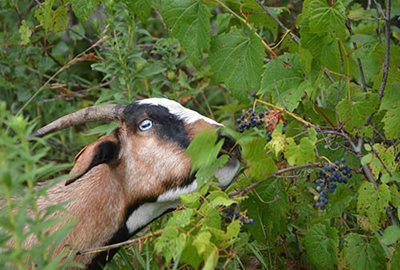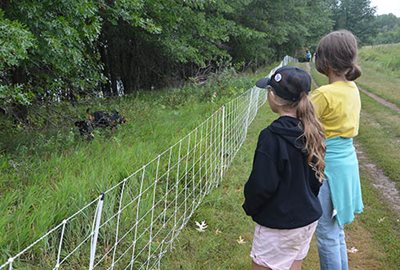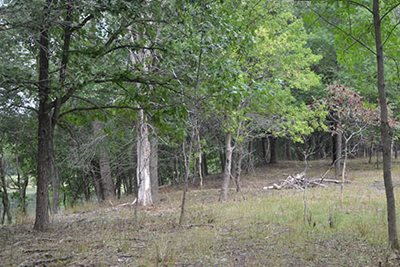 Tromping along a trail in Lake Elmo Regional Park Reserve with a group of Girl Scouts from Woodbury, we stopped a hiker and asked, “Have you seen the goats?”
Tromping along a trail in Lake Elmo Regional Park Reserve with a group of Girl Scouts from Woodbury, we stopped a hiker and asked, “Have you seen the goats?”
We had been following an electric fence for at least a quarter mile, and we could see where the goats had been — the buckthorn and other ground cover between the trees had been denuded or eaten completely.
“Oh, yes,” the hiker assured us. “They are up over that rise. You might smell them before you see them!” We quickened our pace.
Sure enough, we got a whiff on the afternoon breeze — livestock ahead! We could also hear a few collar bells before we came upon the herd of more than 50 goats, all sizes, munching away on shrubs between the trail and shoreline of Eagle Point Lake.
Goats have one big advantage over other management techniques
Goats are among a suite of management tools that regional park staff use to reduce the presence of undesirable plant species. Goats are cost-competitive to other methods and have one big advantage: people love them.
“The goats help connect people with nature,” said Dan MacSwain, natural resources coordinator for Washington County Parks. “They are much more appealing than watching a skid steer brush cutter.”
“Grazing is a natural process – it’s been on the planet for millions of years,” MacSwain explained. “The goats help us reduce our use of herbicides and human labor.”
Washington County Parks contracts with the Ecological Service Livestock Network for goat services at both Lake Elmo Park Reserve and Cottage Grove Ravine Regional Park. At Lake Elmo, goats are grazing primarily in areas where park staff are restoring a landscape type called oak savanna.

Restoring historic landscapes
In Minnesota, the oak savanna landscape historically formed a transition zone between the prairie in the west and mixed forests in the east. Grazing and browsing by bison, deer, and elk — as well as fires set by lightning or by Native Americans — made the savanna a relatively open landscape, with the dominant tree species the fire-tolerant bur oak. Without grazing and fire, those landscapes quickly fill in, often with species that have been introduced to the state more recently.
MacSwain said the goats are part of a suite of restoration practices to restore oak savanna that includes:
- Seeding
- Collecting fallen trees and branches to prepare for future controlled burn or mowing
- Thinning tree species like box elder and elm
- Cutting and treating larger diameter stems that have grown out of shrub state
Restoring the oak savanna is part of long-term habitat restoration and conservation plan for Lake Elmo Park Reserve. The county has received more than $700,000 in grants over a period of seven years from a variety of public and private sources to restore 436 acres of both prairie and oak savanna. An expanded land area totaling 570 acres will in the future be managed using conservation haying or grazing and increasing use of fire.
During 2021 and 2022, the goats have been munching on buckthorn and honeysuckle on 52 acres of areas mostly near lakes and wetlands in the park, at a cost of between $200 and $250 per acre. The major cost is for human labor to put up, move, and remove the electric fencing that keeps the goats contained.

Goats hired for seasonal work at several regional parks
Goats were introduced into the regional park system in 2013 when they were used for buckthorn control at Gale Woods Farm, a special recreation feature in Three Rivers Park District. They have also been put to work by the Minneapolis Park and Recreation Board, Saint Paul Parks and Recreation, and Dakota County.
The review from the Girl Scouts?
“Goats are very cool and very intelligent,” said Emma. “They eat a whole lot of food in one day!”
“It was a really fun walk,” said Katie. Eleanor shared, “I think it’s important to have the goats because they help clear invasive species. I learned about buckthorn and garlic mustard and that it’s invasive.”
Dakota County prepares for the return of American bison
In July, Dakota County Parks broke ground on a project to reintroduce the American plains bison to Spring Lake Park Reserve along the Mississippi River near Hastings. The county will reintroduce up to 15 bison in fall 2022.
The bison will help manage and diversify roughly 160 acres of prairie in the park. Bison graze primarily on grasses, allowing wildflowers to thrive. Their grazing and wallowing (rolling on dry ground) behaviors contribute to new plant growth by pushing seeds into the soil. Park visitors will have opportunities to learn about the prairie ecosystem, the bison, and the bison’s relationship with Indigenous peoples. Learn more about the bison restoration project.
Regional policies support native habitat protection, restoration
The Metropolitan Council plans for the overall regional park system and provides funding for park acquisition and development. The Met Council’s 2040 Regional Parks Policy plan notes that regional park reserves “are expected to provide a diversity of outdoor recreational opportunities…[and] to provide, protect, and manage representative landscape types of the original major landscape types in the metro area.” Read more about the parks policy plan.